Wednesday, April 22 2015
Cycads have evolved and adapted to grow in a range of habitats and weather conditions world wide. However, plant species with a variety of shades of blue can be found arid hot habitats. Palms and cycads are just two of the types of plants that can display blue leaf colorations. Succulents and cacti also are heavily represented with a variety of blue shades.
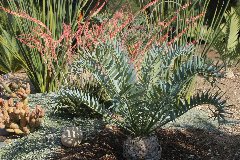 |
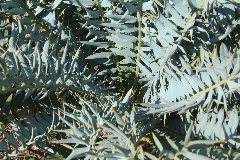 |
| Encephalartos horridus |
Encephalartos horridus close-up |
The blue coloration that is associated with certain plant species is actually due to a thin waxy substance that is produced by the plant to provide some protection from heat and sun exposure. It also helps the plant to retain moisture by protecting the plant from desiccation or excessive transpiration. This waxy substance isn’t actually blue-ish in color, but more in the range of off-white. As a thin coating on the green leaves it gives a visual appearance that the leaves are blue.
The waxy coating can be easily rubbed with your fingers to expose the green leaf beneath. This coating also can begin to wear off naturally from older leaves that have been on the plant for a season or longer.
In the future when we hear the comments from others that “the blues are so beautiful,” perhaps we may realize that their beauty is only skin deep.
Grow and prosper,
Keith
Saturday, February 21 2015
I would like to share information about a valuable garden tool with you. If you do your own maintenance of the palms and cycads that you grow, this tool will likely be used as much as your shovel or rake. I rate this tool very highly on my list of must-have tools for the trade.
A few years ago I was pruning some of the lower leaves of a Phoenix dactylifera that had about five feet of clean trunk. A friend of mine stopped by and happened to see that I was laboring with a small (two foot blade) bow saw. He said that he had a cordless battery powered "Saws All" type of reciprocating saw in the trunk of his car, and he said that he used it for all kinds of pruning and trimming jobs in his yard. He offered it to me to use. Although I have a reciprocating saw of my own, I thought that I would accept his offer, and give it a try. Since I could trim the leaves that needed removal while still standing on the ground, I could control the saw with two hands, but I could not control where the leaves would fall.
After having completed all of the trimming necessary on the Phoenix palm, I began to question myself why I hadn’t used my own reciprocating saw to make the task much easier.
(See Figure 1.) Then it dawned on me why I hadn’t. First of all my reciprocating saw is not powered with a rechargeable battery, so a long extension cord is needed. Secondly it is so large that it requires both hands to safely operate. Since I was standing comfortably with both feet on the ground, I was able to use both hands to operate and control the standard size reciprocating saw that my friend had loaned me. But more often than not, when I prune palm or cycad leaves, I prefer to use one hand to hold on to and control the leaf being cut and the other hand to control the cutting instrument (pruner, or bow saw, etc.). Often there are smaller plants nearby that I do not want damaged by falling leaves. To further complicate the cutting process I am occasionally standing on a ladder to access the lower leaves of my cycads. Oh, sorry, that was an “in my dreams” Freudian slip. I meant to say “lower leaves of my palms” instead of “cycads.”
| 1 - Electric Reciprocating Saw |
2 - Battery Powered One Handed Reciprocating Saw |
3- Pruning Blades and the Additional Larger 12v Battery |
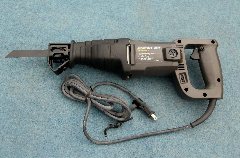 |
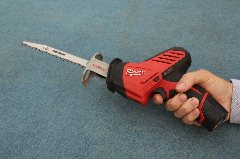 |
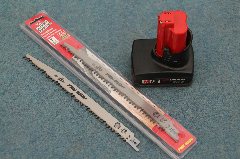 |
Well to make a long story slightly longer, a few months later, I happened to be shopping at a Home Depot (home improvement center), and I decided to take a look at battery powered reciprocating saws. I saw several of the standard sizes and models with battery packs as well as some with power cords. AND THEN I SAW THE GAME CHANGER! (Flashing lights and the sound of trumpets.) This little beauty brought the same twinkle to my eye that Ralphie had when he finally received his beloved Red Rider BB gun in the classic movie Christmas Story. Yes, finally someone had designed a battery powered reciprocating saw that could safely be operated WITH ONE HAND. (See Figure 2.) Thank you Milwaukee! Although I believe there are other good brands of single hand operational reciprocating saws, I chose the Milwaukee brand, and I have been very happy with its ease of operation and comfortable grip. No, I do not have stock in Milwaukee. (Perhaps I should.)
This model has larger capacity additional batteries available. It also has blades that are designed for pruning, which I prefer, but I have a friend who prefers the smoother cut of the blades that are designed to cut metal. (See Figure 3.) I believe that he said that the finer teeth of the metal cutting blades tend to leave a smoother cut surface on the petiole (leaf bases) of his palms and cycads. I think that the coarser cut surface that occurs with the standard pruning saw blades is just fine for me, and its coarser teeth seem to cut through the palm and cycad leaf bases faster.
It is also worth mentioning that the smaller saw can be operated comfortably with either hand. This is helpful because the user fatigue factor between the larger reciprocating saw and its smaller, lighter counterpart is significant, especially if you are putting in an extended time period of pruning. (See Figure 4.)
| 4 - Size Comparison of Electric and Battery Powered Reciprocating Saws |
5 - Clockwise from top - Tote Bag, Larger Battery, Pruning Blades, Saw with Smaller Battery Inserted, Charger Stand |
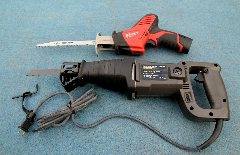 |
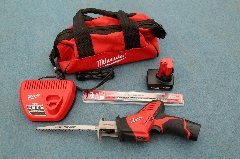 |
Along with the saw motor and its gripping assembly, a small rechargeable12 volt lithium ion battery is included, and is already plugged into the handle grip in these photos. Also included is a battery charger stand. Milwaukee also provides a handy canvas tote bag for storage and transport convenience. I purchased separately pruning blades, as well as an additional (larger) rechargeable 12 volt lithium ion battery, so that I could alternately change out and recharge batteries as needed. (See Figure 5.) I am not sure where prices are now, but I paid about $220.00 for the six items mentioned above. Milwaukee provides packets of saw blades for varying applications, as well as additional batteries, and they are sold separately.
I would have to say that the time I save with this single hand reciprocating saw is at least one half as much time as would be needed if I were using pruners, loppers, or a bow saw. The time saved makes for a pretty rapid payback, if you have a modest to large garden to maintain.
Grow, prune, and prosper,
Keith
Saturday, August 09 2014
Taking off the cycad pups or cycad "babies" is one of the ways to propagate new cycads. Over the years I have developed a number of techniques for pup removal that have resulted in growing healthy cycads. Below I am sharing a video which gives you a brief overview of the process.
>
If you would like the step by step detailed instructions, we have a DVD available. CLICK HERE
Sunday, February 02 2014
I am often asked what to look for when buying a cycad. For me, there are several things that come to mind that I feel are important criteria. First of all I usually look at the overall appearance to try to determine the general health of the plant. Of course you want a nice looking plant. However cycads can be deceiving at times. Occasionally a healthy cycad can look somewhat scraggly if it has recently been subjected to hail or windy conditions. This can cause the leaves to look a little beat up, but often this is something that the plant will rectify when a new flush of leaves is produced in spring or early summer.
The next thing that I will look at is how large the caudex or trunk of the cycad is. This portion of the plant is an essential element. It is the source of both the leaves of the cycad and the roots as well. It is where water and food is stored for times of drought. The size of the caudex will also give a good idea of how many leaves can be produced and also whether the plant is a juvenile plant of has reached or is approaching adult or coning size.
Cones on cycads are the reproductive structure that enable seed production to take place. Cycads are dioescious, which means that each plant is either a male or a female plant for the duration of its life. If a cycad is coning age (usually 10-20 years old), it usually has reached nearly “full footprint,” or it has nearly reached its full diameter. Diameter of the caudex is very important, because the larger it is, the fuller the flushes of leaves it can produce, and the greater the capability for producing multiple cones, or coning more frequently. As always budget comes into the picture, and you should purchase the biggest caudex that you can afford at the time.
Finally I will squeeze the main caudex and any of its visible offsets (pups) with inward pressure of both hands to determine whether the caudex is firm or somewhat mushy, or gives way under compression. If it does compress, I would not invest in that plant. It likely is suffering from any of a number of conditions that generally are not healthy.
The roots are the portion of the cycad that are the most difficult to assess, since they are out of sight. There is little that can be done to determine their condition. You can very gently move aside some of the soil and spot check the top portion of the roots to inspect their health. If all else looks good and feels firm, the odds are that the plant is healthy.
Grow and Prosper,
Keith
Tuesday, November 26 2013
Perhaps the time has come, or is even past due, for people in the trade, in the societies, and those who are simply enthusiasts to consider a campaign to change the name “Sago Palm” to “Sago Cycad.” On the face of it, it doesn’t seem like it’s any big deal to keep it as is, after all, it’s just a name, right? And a nickname at that.
Well, let’s take a closer look. First of all I can’t tell you how many people in southern California own Sago Palms, but have never heard the term “cycad.” Additionally they don’t realize that they actually own one of the most popular species of cycads in the world. Perhaps many of you have had people ask, “What is a cycad,” but they are familiar with a “Sago Palm.” Or you may have noticed some people who may have heard the word “cycad,” but they just can’t quite remember how to say it, and call it a “cy-ad.” The term “palm” added to the name of perhaps the best known cycad is not only misleading, but does nothing to inform or educate the public that cycads are different from palms.
I am fortunate to be serving on the board of the U.S Cycad Society. I was recently (October 2013) appointed to chair the Education Committee, and after thoughtful consideration, I felt compelled to make one of my first orders of business to start a campaign to correct this longstanding misnomer from “Sago Palm” to “Sago Cycad,” or to use it’s botanical name “Cycas Revoluta.” This simple correction can do wonders to educate the general population as well as those already in the nursery industry. And this is perhaps the first and most important step in helping the public to appreciate these amazing prehistoric plants.
Somehow it seems to be an ironic disservice that the most popular and most well known cycad in the world is saddled with a common name that describes it as a palm. I feel quite certain that there is no palm with a common name that describes it as a cycad. “Sago Palm” was probably coined as a convenient reference term that reflected the plant’s appearance and similarity to a palm, and I believe that there was probably no intent to deceive by early nurserymen and growers when the moniker was adopted. However, at the risk of appearing to rock the boat, I believe that reliable data, when known, should trump all previous data or information, if it is truthful. Nearly all other cycads (with only a few exceptions) are referred to by their botanical name. But if changing the common name of “Sago Palm” to its more descriptive name, “Cycas revoluta,” is just too much to swallow, and is too big of a jump for the general public, who usually prefer the common name, then its reference could always defer to a “new” common name of “Sago Cycad.” This would be botanically appropriate and would help to give the “Sago Cycad” a more appropriate classification in the world of botany.
Grow and Prosper,
Keith
Sunday, September 29 2013
Nurseries and plant specifiers have been promoting the use of drought tolerant plant material in order to feed the seasonal demand by landscapers, homeowners, and collectors. Reflecting back on the last few years of the market shift to a xerophytic emphasis has shown that cycads can hold their own when used in drought tolerant landscape plantings.
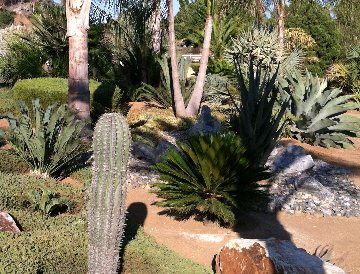
This is, of course, not new information to anyone who has some knowledge of cycad native habitat worldwide. Approximatelyhalf of all known cycad species have significant drought tolerant capabilities. These would consist of cycads whose native habitat is in the dryer regions around the globe. These include many blue Encephalartos species from Africa, many fine leaflet forms of Dioons from Mexico, and many of the Macrozamia species from Australia. Even some species that are native to more tropical or subtropical habitats have shown to be surprisingly resilient when they are established.
Here in southern California many of the larger, more established cycads could actually survive on the seasonal rainfall alone. It is worth noting that larger, more established specimens have developed a mature root system and a significant size caudex (trunk), both of which help to feed and maintain hydration of the plant system during times of drought.
Cycads have proven their versatility when combined with tropical theme landscaping, as well as xerophytic landscape plantings, and they are always able to maintain their own identity.
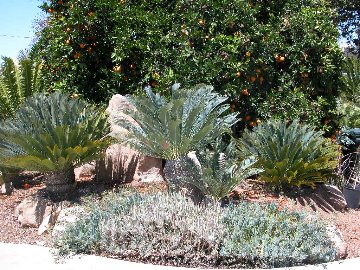
This isn’t to say that all cycads thrive in all positions in the garden. As you study and try various species, you will find that nearly every species would have subtle location preferences if they could make that choice for themselves. As an example, many of the green species of Encephalartos can be grown in full sun if there is significant humidity in the air and little or no seasonal frost. While that same plant, in a dryer, warmer location may benefit from receiving just morning sun for half a day, and then receiving partial or full shade for the remaining part of the day. Plant placement is a subtle but significantly important variable that is worth consideration at the time of planting. As always try to group plants of compatible material that will have similar water requirements.
Grow and prosper,
Keith
Tuesday, August 13 2013
All cycads in cultivation today descend from their ancient ancestors, which grew in the wild. The native habitat for cycads is “the tropical, subtropical and warm temperate regions of both the north and south hemispheres.” (“Cycads of the World” by David L. Jones.) Today the numbers of cycads still thriving in the wild are dwindling; urban encroachment, clearing for agriculture, and poaching being the biggest culprits. Encephalartos woodii is one species which is extinct in the wild. There was only one plant ever found. The last of the stems from the original woodii were transferred from the wild to botanic gardens in 1916. (For a complete list of endangered species of plants and animals see the IUCN Red List of Threatened Species at http://www.iucnredlist.org/ and search cycads.)
Cycads reproduce primarily in two ways. One way is by seed. This process requires a male plant that generates the cone with the pollen, and a female plant with a cone which holds the seeds. Natural pollination is accomplished by native insects (beetles) that carry the pollen from male cone to female cone. In cultivation pollination is often done by man. The second means of propagation is vegetative, or by offset, or pup. Since there was only one woodii ever found in the wild (male), propagation by seed is not feasible, and all true woodiis today are descendants by offset of that original plant from the wild. They are genetic clones of the original plant.
Since most woodiis belong to botanic gardens or private collections, and since cycads are relatively slow-growing, true woodiis rarely become available for sale on the open market. It is not unheard of for collectors to submit their names to a grower to be included on a waiting list to purchase a woodii pup. And still potential buyers may end up waiting many years for the opportunity to own a woodii.
For these reasons offsets of Encephalartos woodii command a hefty price. Viewing an Encephalartos woodii is a rare opportunity, and the opportunity to purchase one of the rarest cycads in the world is even more uncommon.
Grow and prosper,
Laurie
Thursday, July 25 2013
As mid summer approaches, there are many cycad growers on “cone watch.” This is the time of year when cones begin to emerge in our gardens, if fortunate enough to have sexually mature plants. North of the equator cones can begin to emerge between June and August, and usually reach maturity within one to six months from full emergence.
For the intrepid few that choose to try to make their cycads productive and can locate both male and female cones maturing simultaneously, there is a small window of time in which you can assist in the production of viable seed. This involves what is commonly termed “hand pollination.”
Hand pollination can be achieved by delivering pollen into the interior void areas of the female cone when it becomes receptive. This process can be done with dry pollen or adding the pollen to water and pouring that mixture into the void channels of the female cone and repeating the process several times within the perceived period of receptivity at one to five day intervals.
It is important to note that caution should be taken not to use the water method if the female cone does not visibly show any exposed peduncle. The peduncle is the stem of the cone which attaches the cone and the caudex. See photo #1.
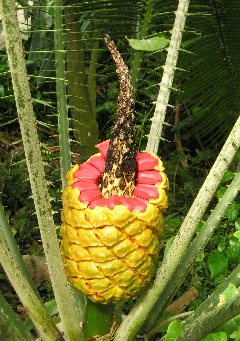
Female encephalartos Vilosus cone joined to the caudex by the peduncle - Wikimedia.org
If there is no peduncle showing, and the cone is tightly nested into and in close contact with the caudex or trunk of the female cycad, the use of water while pollinating should be cautiously undertaken or avoided altogether. See Photo #2.
 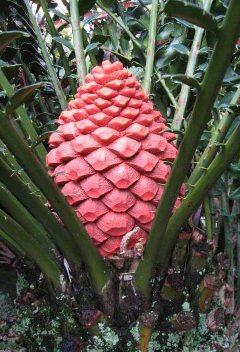
Female encephalartos cone nested in caudex - nzpalmandcycad.org
My first attempt at pollinating any cycad was back in 1978, and I used the pollen/water method. The cone was nested closely to the caudex with no separation showing, i.e. no peduncle. The pollen/water mixture that I was pouring through the cone from the top down was trickling down through the cone and gathering in the top portion of the caudex. Well, as many of us know, standing water in contact with any portion of a cycad is usually a bad combination. After a few months as I was waiting for the cone to mature and break down (dehisce), the cone and the caudex began to turn to mush. My first lesson learned was that water as a pollen delivery system is OK, but the water mixture needs to have a way to drain away from the caudex and not be trapped in the caudex crown.
If the aforementioned condition exists as you are pollinating cones (the female cone is embedded in the nest of the top of the caudex), I would recommend one of the many techniques that involves the use of compressed air to deliver your pollen through your cone as a dry pollen delivery technique.
Grow and prosper,
Keith
Tuesday, June 25 2013
Back in the early 90’s, I had a very close family friend who worked at Roger’s Gardens in Orange County, CA. She knew that I was enthusiastic about growing cycads, and she suggested that I bring some of my cycads to the annual sale that the gardens sponsored in the spring. I took a good selection of material to my display space that was provided. One day when we were discussing the different species of cycads, she was referring at one point to some of the larger size cycads with their myriad shades of green, and she called them “big greenies.” I don’t know if this was her term, or if it was a term common to Rogers Gardens employees when referring to larger foliage plants. That term has stuck with me, and I still refer to any of the non blue species of cycads as “big greenies.” And yes, I do include the appropriate species label.


In my early years of collecting, many of the seedlings that were available, but still relatively scarce, were of the genus Encephalartos, and they were, for the most part, the medium to large green species. As my collection grew and rarer forms became more available, my “big greenies” were reaching a more advanced juvenile stage (not quite full mature footprint). During this period of time, the “blues” (any blue leaf colored cycads) gained in popularity, almost to the exclusion of the green forms all together. I believe that this was partly because most back yards in southern California just didn’t have enough space for a sizeable collection of the larger green form cycads.
The trend for collectors to seek out the blue forms is not without merit, because it is difficult to argue against the logic of collecting any of the striking blue leafed cycad species with their wonderful varieties of leaves and cones.
As I reflect on the material that I have collected, I have no regrets that I acquired material in the order that I did. Although it would be nice to have some of my blues in sizes that approach the size of my “big greenies,” the green species of cycads will almost always grow faster, and be more robust than the blue forms. However, the “big greenies” in their mature form always seem to draw attention in the garden, whereas in more juvenile sizes, they are hardly noticed. The sheer size of mature “greenies” and their fullness and stateliness is what makes the difference.
To give the “big greenies” their proper regard, I can’t imagine not having the considerable variety of green and blues together with their interesting contrasts of color, size, and form. In your gardens and collections, don’t overlook the bold statement that these regal “big greenies” can add, even if you only have room for a few.
Grow and prosper,
Keith
Monday, May 27 2013
In the warmer spring months following a fairly cold January and February, we are happy to see many of our cycads in the ground and in containers begin to push new leaves. This winter we had some very cold temperatures, resulting in many frosty mornings, and even a couple hail storms.
 As you might expect, we had a lot of cold damage in the garden. And as a result, March and April of this year, much of my time in the garden was spent removing frost bitten, brown cycad leaves. The damage this year was reminiscent of the damage from “The Winter that Rocked My World”, the blog from December of 2012. As you might expect, we had a lot of cold damage in the garden. And as a result, March and April of this year, much of my time in the garden was spent removing frost bitten, brown cycad leaves. The damage this year was reminiscent of the damage from “The Winter that Rocked My World”, the blog from December of 2012.
But now that leaves have been cut back, it is easy to see how spring rains, sunshine and longer days have done their magic once again, and these hearty plants are pushing new leaf flushes. This is when it is time to give nature a helping hand and pump this growth with fertilizer.
I have made an effort to grow my cycads using as little chemical fertilizer as possible. I really like the idea of growing nearly all of my plants with organic nutrition. The one time of the year that I break with tradition is when I have plants pushing new leaves. I like the fact that the occasional seasonal shot of a water soluble plant food gives the plant immediate access to absorb useful nutrients.
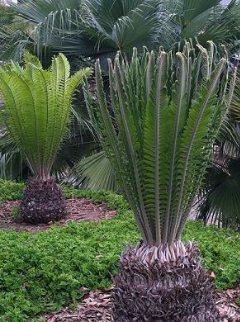
I know that it can be argued that chemical fertilizer can do more harm than good, but I do use it sparingly and primarily during the time of leaf production. The repeated use of chemical fertilizer can deplete and damage many of the beneficial organisms in a healthy soil, but I don’t think that the occasional use will have a devastating effect on the soil.
After leaves have hardened off, my fertilizer applications include mostly organic components. This helps to feed, repair, and replace colonies of micro-organisms in the soil that may have sustained damage from chemical fertilizer applications.
As you can see, I have taken a middle of the road approach to the application of fertilizer. The debate of “chemical or organic” is likely to persist, but in time, each grower will usually settle on what works for him/her. This feeding process has proven successful for me.
Grow and prosper,
Keith
|
|
|